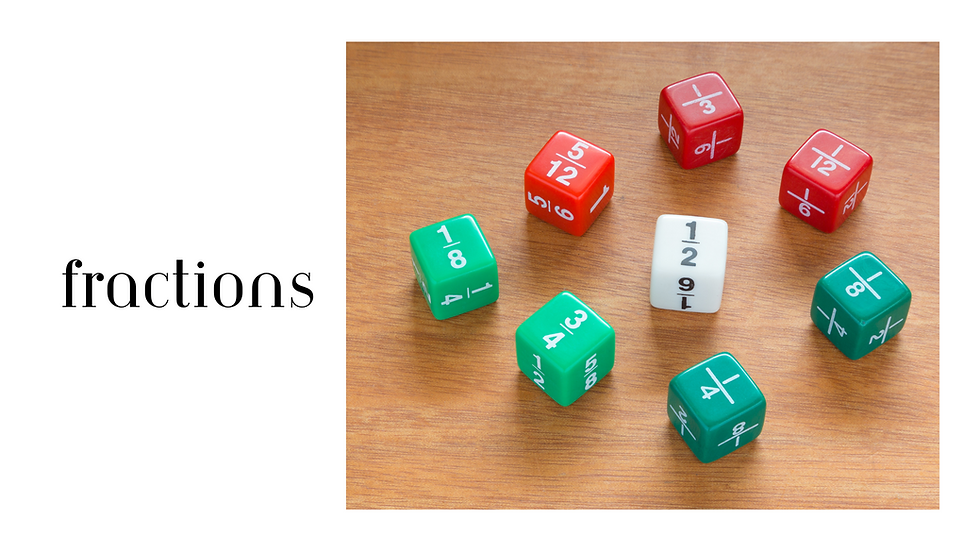Year 8 Term 1 Week 3 - Fractions
- Sallyann Clark

- Aug 31
- 3 min read
Updated: Sep 5

Week 3: Fractions – Addition and Subtraction
Introduction
This week, we review how to add and subtract fractions, including working with improper fractions and mixed numbers. These are essential foundations before we move on to multiplication, division, percentages, and algebra with fractions.
What should I already know?
How to simplify fractions.
How to find equivalent fractions.
How to convert between improper fractions and mixed numbers.
If you need to recap these skills, watch Math Antics: Simplifying Fractions.
The Maths Guy!: Equivalent Fractions.
Maths with Mr J: Converting Mixed Numbers to Improper Fractions.
Real-World Application – Why This Maths Matters
Fractions are used in everyday life whenever amounts need to be combined or shared. Cooks use fractions when doubling or halving recipes. Builders use fractions when cutting materials. Subtracting fractions is just as important, imagine removing a fraction of an ingredient, or calculating how much fabric is left over.
Day 1 – Adding and Subtracting Fractions with Like Denominators
What am I Learning Today?
I will be learning to add and subtract fractions that have the same denominator.
Revision reminder
You should already know how to simplify fractions. We covered this in Week 1, and you can use the video above to recap if needed.
Game
Fraction Matcher – PhET. Try to complete as many levels as you can.
Learn
Task
In your Journal:
Write the title Fractions
Write what you already know about fractions - denominator, numerator, method for adding and subtracting, examples of equivalent fractions, a definition for simplifying fractions...
Conclusion
You can now add fractions with the same denominator by adding the numerators. Tomorrow, we will look at multiplying and dividing fractions.
Day 2 – Adding and Subtracting Fractions with Unlike Denominators
What am I Learning Today?
I will be learning to add and subtract fractions with different denominators by finding equivalent fractions.
Revision reminder
You should already know how to find the lowest common multiples. If you need a recap, watch Maths with Mr J: How to Find LCM (2 different ways).
Game
Play LCM on Maths Kite.
Learn
Task
In your journal:
Add examples of adding and subtracting fractions with unlike denominators.
Conclusion
You can now add fractions with different denominators by rewriting them as equivalent fractions with a common denominator. Tomorrow, we will be looking at improper fractions.
Day 3 – Improper and Mixed Fractions
What am I learning Today?
I will be learning to convert between improper fractions and mixed numbers in calculations.
Revision reminder
You should already know how to simplify improper fractions. If you need a recap, watch Maths with Mr J: Converting Improper Fractions to Mixed Numbers.
Game
Play Wordwall: Mixed Numbers and Improper Fractions
Learn
Khan Academy: Arithmetic Unit 5 Lesson 12 Mixed Numbers
Task
Complete the worksheet.
Conclusion
You can now work confidently with improper fractions and mixed numbers in addition and subtraction of fractions. You will practice this more tomorrow.
Day 4 – Adding and Subtracting Fractions and Improper and Mixed Fractions
What am I learning Today?
I will practice adding and subtracting fractions that include improper fractions and mixed numbers in calculations.
Game
Play Wordwall: Mixed and Improper Fractions.
Task
Conclusion
Well done on working so hard, adding and subtracting fractions!
Day 5 – Project: Recipe Adjustments
What am I Learning Today?
I will be learning to apply fraction addition and subtraction to real-life recipe problems.
Introduction
Imagine you are baking! You need to combine different fractions of recipes and adjust quantities for different servings.
Task – Recipe Adjustments
A cake recipe needs 3/4 cup sugar. You are making two cakes. How much sugar is needed?
A biscuit recipe uses 2 1/2 cups of flour. If you only want half the recipe, how much flour do you need?
You bake 2/3 of a batch of brownies on Monday and 3/5 of a batch on Tuesday. How much is baked in total?
Challenge: You make 2 batches of cookies. One requires 1 1/2cups butter, the other requires 2 1/3. You only have 3 cups of butter. How much more do you need?
Conclusion
Today, you have applied fraction addition and subtraction to a practical context. Fractions are vital in real life whenever you combine or adjust amounts.

